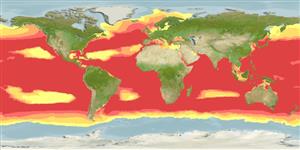Common names from other countries
Classification / Names / Names
Namen | Synonyme | Catalog of Fishes (gen., sp.) | ITIS | CoL | WoRMS
Environment: milieu / climate zone / depth range / distribution range
Ökologie
Bathypelagisch; tiefenbereich 0 - 1000 m (Ref. 96968). Subtropical
Worldwide except polar waters.
Length at first maturity / Size / Gewicht / Alter
Maturity: Lm ? range ? - ? cm Max length : 45.0 cm TL Männchen/unbestimmt; (Ref. 96968)
Found in mesobathypelagic waters of tropical and subtropical regions (Ref. 115077). Depth range from near the surface to at least 1,000 m, typically over deep water (beyond the continental shelf) (Ref. 96968). Thought to be found mostly near islands and sea mounts (Ref. 115077). Video sequences from submersibles suggest that the male envelops the female within his webs during mating. Females are thought to brood their eggs within their arm crown (Ref. 96968). Faint and less developed beak could be a sign of soft-bodied prey diet of early stages (Ref. 115077).
Life cycle and mating behavior
Geschlechtsreife | Fortpflanzung | Ablaichen | Eier | Fecundity | Larven
Members of the class Cephalopoda are gonochoric. Male and female adults usually die shortly after spawning and brooding, respectively. Mating behavior: Males perform various displays to attract potential females for copulation. During copulation, male grasp the female and inserts the hectocotylus into the female's mantle cavity where fertilization usually occurs. Life cycle: Embryos hatch into planktonic stage and live for some time before they grow larger and take up a benthic existence as adults.
Turgeon, D.D., J.F. Quinn Jr., A.E. Bogan, E.V. Coan, F.G. Hochberg, W.G. Lyons, P.M. Mikkelsen, R.J. Neves, C.F.E. Roper, G. Rosenberg, B. Roth, A. Scheltema, F.G. Thompson, M. Vecchione and J.D. Willams. 1998. (Ref. 1667)
IUCN Rote Liste Status (Ref. 130435)
CITES Status (Ref. 108899)
Not Evaluated
Not Evaluated
Nutzung durch Menschen
| FishSource |
Tools
Mehr Information
Alter/GrößeWachstumLänge-GewichtLänge-LängeMorphologieLarvenDichte
Internet Quellen
Estimates based on models
Preferred temperature
(Ref.
115969): 6.1 - 20.4, mean 12.2 (based on 1932 cells).
Preiskategorie
Unknown.
